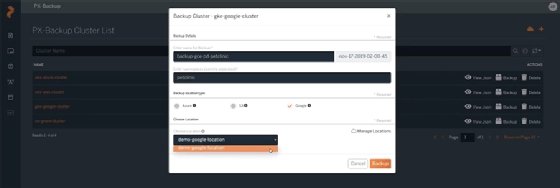
artemegorov - stock.adobe.com
Portworx ships backup, capacity management for containers
Portworx's storage product tacks on PX-Backup and PX-Autopilot for Capacity Management modules for enterprises building stateful containerized applications.
Portworx is adding backup and capacity management for Kubernetes applications that require persistent storage in anticipation of enterprises expanding their use of containerized workloads.
The startup added the new capabilities as modules to the Portworx Enterprise storage management platform.
Portworx made available a technology preview of new PX-Backup software that can protect individual containers, groups of containers or a full Kubernetes namespace with a single command to any S3-compatible object storage. The Los Altos, California vendor expects PX-Backup will be generally available by the end of 2019.
PX-Backup will not require the primary Portworx Enterprise storage management software platform. The backup software will also work with non-Portworx volumes that use AWS Elastic Block Store, Microsoft Azure Disks, Google Persistent Disks and VMware. PX-Backup can also protect distributed databases such as Cassandra, Kafka, Elasticsearch and MongoDB, according to Portworx.
New PX-Autopilot for Capacity Management software lets customers set rules to monitor their infrastructure and take automated actions. For instance, the Portworx software can detect when capacity may runs low and automatically provision additional cloud storage. The feature saves users from having to pay upfront for more storage than they need.
The PX-Backup and PX-Autopilot for Capacity Management add-ons complement other modules that Portworx has tacked on to its main Portworx Enterprise container storage, including PX-DR for disaster recovery and PX-Secure with encryption and access controls.

Backs up AWS, Azure, Google disks
PX-Backup uses the native APIs of AWS, Azure, Google and VMWare to take backups of volumes associated with a Kubernetes application, as well as the Kubernetes application configuration and Kubernetes objects, according to Michael Ferranti, the startup's vice president of product marketing.
Portworx introduced backup capabilities in May with its Enterprise 2.2 release, but Ferranti said they targeted existing customers with a command-line interface-driven option rather than one featuring a graphical user interface (GUI). Also, because the backups did not contain metadata, they were not indexed and searchable, so customers had no easy way to find a backup taken on a particular date or set policies to delete backups, Ferranti said.
Portworx CTO Gou Rao said the backup software now catalogs volumes and scans metadata as it backs up the containerized applications to make it easier for users to recover the data.
"You point and click at a GUI and say, 'I need a database from six months ago.' And, boom, they can restore the application pod because it just comes off of an object store within a matter of seconds," Rao said.
Rao said Portworx built a new control plane interface to "plug into the Kubernetes way of doing things." He said traditional software typically backs up an entire virtual or physical machine, but Portworx takes a different approach because a Kubernetes-based application runs as multiple containers on separate systems simultaneously.
Appeal for risk-averse enterprises
"Adding backup capabilities makes the platform appealing to even those enterprises that are risk averse and are waiting to adopt container architectures in full-blown production," said Archana Venkatraman, a research manager at IDC. "Having all data services in one platform also helps eliminate integration complexities for users who are new to the container world."
Jerry Rozeman, a senior research director at Gartner, said traditional backup options often focus on protecting persistent data, but Portworx is Kubernetes namespace-aware and backs up data and the application configuration.
"Backing up an active application like a database can be a challenge on any infrastructure, and adding containerization to the mix makes things somewhat more complex, especially when you want to be able to spin up a crashed application with the shortest possible RTO and RPO," said Steven Hill, a senior analyst at 451 Research. "Insuring application availability is a key goal these days, so it's not only about protecting the data, it's also about being able to provide application-level consistency for full recovery purposes."
Portworx adds capacity management
Customers can use the new Portworx PX-Autopilot for Capacity Management on a granular application or namespace level or for an entire Kubernetes cluster, Rao said. He said Portworx wrote a rules-based engine and hooked it into the telemetry from the Kubernetes and storage environments to enable the PX-Autopilot functionality.
Rao said Autopilot provides templates based on common application deployment scenarios that Portworx saw when working with customers over the past few years. DevOps users would save the template's text-based YAML files in the same location that they save their other Kubernetes objects, and they could modify any rules they set using the GUI of their choice.
Hill said capacity management could play a major role in making container adoption more efficient from a storage perspective. He said PX-Autopilot's ability to granularly break out a single AWS Elastic Block Store volume into as many as 2,000 Kubernetes container storage volumes and scale the volume capacity up and down would facilitate the sort of efficiency that thin provisioning does in a traditional storage environment.
"Building anything big and grand in the cloud is very easy, and what companies are struggling to do is right-size their cloud environments," Venkatraman said. "Intelligent and automated capacity management can help users to stop overprovisioning and achieve efficiency."
Portworx plans to charge an extra fee for PX-Autopilot for Capacity Management and PX-Backup, but did not disclose pricing.
Enterprises are still in the early stages of deploying container deployment with persistent storage volumes, so Hill said he expects more vendors would expand their backup and DR options to protect containerized workloads in 2020.
Marc Staimer, president of Dragon Slayer Consulting, cautioned organizations about the potential for overlap between the backup capabilities they get with their existing backup products and those they might add through a container storage specialist. He recommended that large enterprises consider a comprehensive backup and recovery product, whereas departments or smaller organizations might find container-focused storage products useful.





